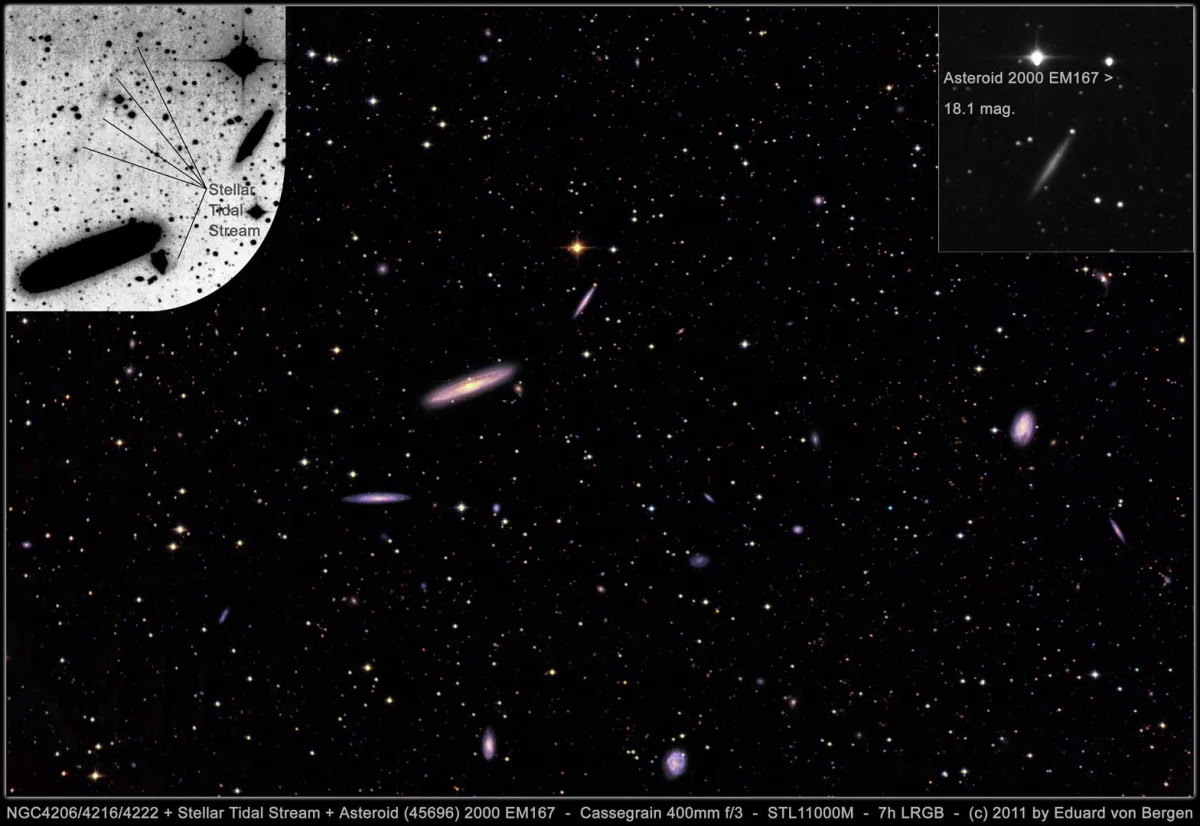Galaxies NGC 4206, NGC 4216 & NGC 4222

History
The two galaxies NGC 4189 and NGC 4222 were discovered on 8 April 1784 by the German-British astronomer William Herschel with his self-made 18.7 inch f/12.8 reflecting telescope in Slough, England. A few days later on April 17, he encountered the galaxies NGC 4193, NGC 4206 and 4216 a little further south. [196, 277] This reveals how Herschel proceeded with his discoveries at the time: He adjusted his long, cable-mounted telescope to a certain altitude and let the earth's rotation pass the sky At night he adjusted his telescope to a different altitude and mapped the next strip.
The double entries IC 3050, IC 3051, IC 3064 and IC 3087 come from the German astronomer Friedrich Carl Arnold Schwassmann, who photographed this area of the sky on September 17 and 16 November 1900 with the 6 inch astro camera of the Königstuhl Observatory in Heidelberg. Neither Schwassmann nor Dreyer It was noticeable that the positions with Herschel's discovered NGC 4189, NGC 4193, NGC 4206 and NGC 4222 coincided, which is why they appeared in the «Second Index Catalogue of Nebulae and Clusters of Stars» published by Dreyer in 1910. This only occurred to the American astronomer in 1930 Adelaide Ames discovered and mapped over 3000 galaxies in Coma Berenices and Virgo. [196, 277]

Physical Properties
NGC 4216 is an SAB(s)b type barred spiral galaxy and is located on the outskirts of the Virgo Cluster, about 4° from its centre (M 87). We see them almost edge-on at an angle of about 85°. In the centre is a red and compact core surrounded by characteristic dusty bands. The galaxy is surrounded by a very diffuse stellar halo with filamentous structures and tidal currents. These structures are thought to result from an earlier heavy bombardment from dwarf galaxies. The very low radial velocity of 129 km/s, which is very different from the Virgo cluster's average radial velocity of 1300 km/s, shows that this galaxy is moving relatively fast with respect to the centre of the cluster. NGC 4216 is the most massive galaxy within a range of 400 kpc radios. The nearest higher mass galaxy is M 99 at a distance of 420 kpc. [444]
The five galaxies belong to the Virgo cluster and are located at a distance of about 16 Mpc to 38 Mpc. Between NGC 4189 and NGC 4222 lies the IAU boundary of the constellation Virgo. NGC 4189 lies north of this limit and is already in the constellation of Coma Berenices. [145]
| Name | RA | Dec | Type | bMag | vMag | B-V | SB | Dim | PA | z | D(z) | MD | Dreyer Description | Identification, Remarks |
|---|---|---|---|---|---|---|---|---|---|---|---|---|---|---|
| NGC 4189 | 12 13 47.2 | +13 25 29 | Gx (SBc) | 12.5 | 11.7 | 0.8 | 13.1 | 2.5 × 1.7 | 85 | 0.007055 | 29.80 | 28.080 | F, L, lE, vglbM, r | WH II 106; h 1131; GC 2783; IC 3050; UGC 7235; MCG 2-31-54; IRAS 12112+1342; CGCG 69-92; VCC 89; KUG 1211+137 |
| NGC 4193 | 12 13 53.4 | +13 10 22 | Gx (SBbc) | 13.2 | 12.3 | 0.9 | 13.0 | 2.2 × 1.1 | 93 | 0.008272 | 34.94 | 37.160 | vF, pL, E, vgbM | WH II 163; h 1134; GC 2787; IC 3051; UGC 7234; MCG 2-31-53; IRAS 12113+1326; CGCG 69-91; VCC 97 |
| NGC 4206 | 12 15 16.7 | +13 01 22 | Gx (Sbc) | 12.8 | 12.2 | 0.6 | 14.1 | 6.4 × 1.1 | 0 | 0.002342 | 9.89 | 19.940 | F, vmE | WH II 165; GC 2795; IC 3064; UGC 7260; MCG 2-31-66; IRAS 12127+1318; CGCG 69-104; VCC 145 |
| NGC 4216 | 12 15 54.0 | +13 08 52 | Gx (SBb) | 11.0 | 10.0 | 1.0 | 12.8 | 8.1 × 1.8 | 19 | 0.000437 | 1.85 | 17.110 | vB, vL, vmE 17°, sbMN | WH I 35; h 1148; GC 2806; UGC 7284; MCG 2-31-72; CGCG 69-112; VCC 167; IRAS 12133+1325 |
| NGC 4222 | 12 16 22.6 | +13 18 25 | Gx (Scd) | 13.9 | 13.3 | 0.6 | 13.7 | 3.1 × 0.5 | 56 | 0.000767 | 3.24 | 25.370 | vF, pS, R | WH II 109; GC 2814; UGC 7291; MCG 2-31-75; CGCG 69-119; IRAS 12138+1334; FGC 1396; VCC 187 |
Finder Chart
The galaxy group is located in the constellation Virgo. The best observation time is November to August, when it is highest at night.
